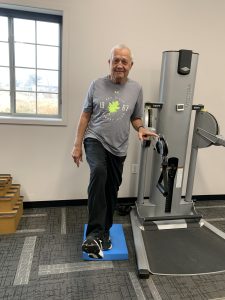Understanding Arthritis: How Physical Therapy Can Help Each Type
October 14, 2025

Arthritis is not a single disease—it’s a term that refers to many different types of joint-related conditions that cause pain, inflammation, stiffness, and reduced mobility. It affects people of all ages and walks of life, and its impact can range from mildly uncomfortable to severely disabling.
While there is no cure for most forms of arthritis, physical therapy plays a vital role in managing symptoms, preserving joint function, and improving quality of life. In this blog, we’ll explore the most common types of arthritis and how physical therapy can help with each.
Osteoarthritis (OA)
What it is:
The most common type of arthritis, osteoarthritis is a degenerative joint disease caused by wear and tear of cartilage—the cushioning material between bones. It commonly affects the knees, hips, hands, and spine.
Common Symptoms:
-
Joint pain and stiffness
-
Limited range of motion
-
Swelling and tenderness
-
Cracking or popping sounds during movement
How Physical Therapy Helps:
-
Strength training to support weakened muscles around the affected joint
-
Low-impact aerobic exercises to improve endurance and reduce fatigue
-
Range-of-motion exercises to maintain flexibility
-
Manual therapy to reduce stiffness and pain
-
Education on joint protection strategies and proper body mechanics
Rheumatoid Arthritis (RA)
What it is:
Rheumatoid arthritis is an autoimmune condition where the immune system mistakenly attacks the joints, leading to inflammation of the synovial membrane. RA often affects joints symmetrically (e.g., both wrists or both knees).
Common Symptoms:
-
Swollen, warm, and painful joints
-
Morning stiffness lasting more than 30 minutes
-
Fatigue and fever
-
Joint deformities over time
How Physical Therapy Helps:
-
Joint protection techniques to reduce stress on inflamed joints
-
Gentle range-of-motion and flexibility exercises to combat stiffness
-
Custom exercise programs to maintain function without triggering flare-ups
-
Splinting or assistive devices to support weak joints
-
Hydrotherapy (exercise in warm water) for low-impact movement
Psoriatic Arthritis (PsA)
What it is:
Psoriatic arthritis occurs in people with psoriasis (a skin condition) and causes joint inflammation along with skin symptoms. It can affect any part of the body, including the spine and fingers.
Common Symptoms:
-
Joint pain and stiffness
-
Swelling in fingers and toes (dactylitis)
-
Nail changes
-
Fatigue
How Physical Therapy Helps:
-
Stretching and posture training to reduce stiffness and spinal strain
-
Hand therapy for fine motor control and dexterity
-
Strengthening exercises to stabilize joints
-
Balance and coordination exercises if the lower limbs are affected
-
Education on flare-up management
Ankylosing Spondylitis (AS)
What it is:
A type of inflammatory arthritis that primarily affects the spine, causing the vertebrae to fuse over time. This can lead to reduced mobility and a hunched posture.
Common Symptoms:
-
Chronic back pain and stiffness
-
Pain that improves with activity
-
Reduced flexibility in the spine
-
Fatigue
How Physical Therapy Helps:
-
Posture correction exercises to prevent spinal deformity
-
Breathing exercises to maintain lung capacity
-
Spinal mobility exercises to delay or reduce fusion
-
Aerobic exercise to improve endurance
-
Pain management techniques, including heat therapy
Gout
What it is:
A form of inflammatory arthritis caused by high levels of uric acid, leading to the formation of crystals in the joints. It often affects the big toe but can occur in other joints.
Common Symptoms:
-
Sudden, intense joint pain
-
Swelling and redness
-
Joint tenderness (even to touch)
-
Limited range of motion
How Physical Therapy Helps (between flare-ups):
-
Education on lifestyle modifications to prevent future attacks
-
Gentle mobility and strengthening exercises once the acute flare resolves
-
Balance and gait training if joints of the foot or ankle are affected
-
Weight management programs to reduce joint stress
Juvenile Idiopathic Arthritis (JIA)
What it is:
A type of arthritis that affects children under 16. It includes several subtypes and can lead to long-term joint damage if not managed early.
Common Symptoms:
-
Swollen and painful joints
-
Growth problems in affected limbs
-
Fatigue or irritability
-
Stiffness, especially in the morning
How Physical Therapy Helps:
-
Play-based exercises to engage children and improve mobility
-
Range-of-motion and strengthening routines appropriate for growing joints
-
Custom orthotics or splints to prevent joint deformities
-
Family education for consistent home support
The Big Picture: Why Physical Therapy Matters for Arthritis
No matter the type, arthritis can impact your mobility, independence, and daily comfort. While medications and surgery may be necessary in some cases, physical therapy offers a non-invasive, personalized, and long-term solution to:
✅ Reduce pain
✅ Increase mobility
✅ Strengthen supportive muscles
✅ Improve balance
✅ Prevent joint deformities
✅ Enhance overall quality of life
Arthritis may be a lifelong condition, but with the right care and guidance—especially from a licensed physical therapist—managing symptoms and staying active is absolutely possible.
If you’re living with arthritis or supporting someone who is, talk to your doctor about getting a referral to physical therapy. The earlier you start, the better the outcome.
